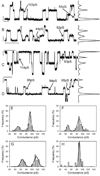Mechanism of v-Src- and mitogen-activated protein kinase-induced reduction of gap junction communication
- PMID: 12388103
- PMCID: PMC2902244
- DOI: 10.1152/ajpcell.00214.2002
Mechanism of v-Src- and mitogen-activated protein kinase-induced reduction of gap junction communication
Abstract
Connexin (Cx)43 gap junction channels are phosphorylated by numerous protein kinases, with the net effect typically being a reduction in gap junction communication (GJC). This reduction must result from a decrease in channel open probability, unitary conductance, or permselectivity, because previous results suggest that channel number is unaffected. Coexpression of v-Src with wild-type Cx43 (Cx43-wt) but not Cx43 with tyrosine to phenylalanine substitutions at 247 and 265 (Cx43-Y247,265F) resulted in reduced electrical and dye coupling but no change in single-channel amplitudes. EGF treatment of cells expressing Cx43-wt but not Cx43 with serine to alanine substitutions at 255, 279, and 282 (Cx43-S255,279,282A) resulted in reduced GJC, also with no change in single-channel amplitude. Dye coupling was reduced to a far greater extent than electrical coupling, suggesting that channel selectivity was also altered but with minimal effect on unitary conductance. The absence of Src- and MAPK-induced reductions in single-channel amplitude suggests that the decreases in GJC induced by these kinases result from reduced channel open probability and possibly altered selectivity.
Figures





Similar articles
-
v-Src tyrosine phosphorylation of connexin43: regulation of gap junction communication and effects on cell transformation.Cell Commun Adhes. 2006 Jul-Aug;13(4):199-216. doi: 10.1080/15419060600848516. Cell Commun Adhes. 2006. PMID: 16916748 Free PMC article.
-
v-Src phosphorylation of connexin 43 on Tyr247 and Tyr265 disrupts gap junctional communication.J Cell Biol. 2001 Aug 20;154(4):815-27. doi: 10.1083/jcb.200102027. J Cell Biol. 2001. PMID: 11514593 Free PMC article.
-
v-Src-mediated phosphorylation of connexin43 on tyrosine disrupts gap junctional communication in mammalian cells.Cell Commun Adhes. 2001;8(4-6):265-9. doi: 10.3109/15419060109080735. Cell Commun Adhes. 2001. PMID: 12064600
-
Mind the gap; regulation of gap junctional, intercellular communication by the SRC oncogene product and its effectors.Anticancer Res. 2012 Oct;32(10):4245-50. Anticancer Res. 2012. PMID: 23060544 Review.
-
Specific Cx43 phosphorylation events regulate gap junction turnover in vivo.FEBS Lett. 2014 Apr 17;588(8):1423-9. doi: 10.1016/j.febslet.2014.01.049. Epub 2014 Feb 4. FEBS Lett. 2014. PMID: 24508467 Free PMC article. Review.
Cited by
-
Agrin mediates a rapid switch from electrical coupling to chemical neurotransmission during synaptogenesis.J Cell Biol. 2005 May 9;169(3):503-14. doi: 10.1083/jcb.200411054. J Cell Biol. 2005. PMID: 15883200 Free PMC article.
-
The roles of connexins and gap junctions in the progression of cancer.Cell Commun Signal. 2023 Jan 13;21(1):8. doi: 10.1186/s12964-022-01009-9. Cell Commun Signal. 2023. PMID: 36639804 Free PMC article. Review.
-
Mechanisms of Connexin Regulating Peptides.Int J Mol Sci. 2021 Sep 22;22(19):10186. doi: 10.3390/ijms221910186. Int J Mol Sci. 2021. PMID: 34638526 Free PMC article. Review.
-
Connexins: Synthesis, Post-Translational Modifications, and Trafficking in Health and Disease.Int J Mol Sci. 2018 Apr 26;19(5):1296. doi: 10.3390/ijms19051296. Int J Mol Sci. 2018. PMID: 29701678 Free PMC article. Review.
-
Phosphatase-resistant gap junctions inhibit pathological remodeling and prevent arrhythmias.Circ Res. 2011 Jun 10;108(12):1459-66. doi: 10.1161/CIRCRESAHA.111.244046. Epub 2011 Apr 28. Circ Res. 2011. PMID: 21527737 Free PMC article.
References
-
- Albright CD, Grimley PM, Jones RT, Resau JH. Differential effects of TPA and retinoic acid on cell-cell communication in human bronchial epithelial cells. Exp Mol Pathol. 2002;72:62–67. - PubMed
-
- Atkinson MM, Anderson SK, Sheridan JD. Modification of gap junctions in cells transformed by a temperature-sensitive mutant of Rous sarcoma virus. J Membr Biol. 1986;91:53–64. - PubMed
-
- Bednarczyk D, Mash EA, Aavula BR, Wright SH. NBD-TMA: a novel fluorescent substrate of the peritubular organic cation transporter of renal proximal tubules. Pflügers Arch. 2000;440:184–192. - PubMed
-
- Bruzzone R, White TW, Paul DL. Connections with connexins: the molecular basis of direct intercellular signaling. Eur J Biochem. 1996;238:1–27. - PubMed
Publication types
MeSH terms
Substances
Grants and funding
LinkOut - more resources
Full Text Sources
Molecular Biology Databases
Miscellaneous

